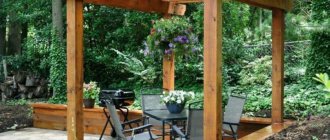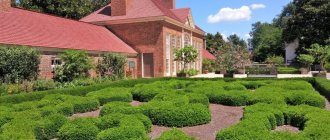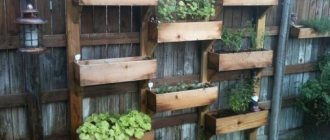Why is a border needed?
Making a border is the final accent in organizing a flower bed.
The border is used for:
- Creating a unified style for all flower beds located on the territory.
- Limitations on the shape of the flowerbed.
- Dividing the territory into separate zones.
- Protecting plants from domestic animals.
- Avoiding trampling of emerging shoots.
To choose the perfect border for your flower bed, you need to understand what it is for.
If the flower bed is located on a hill, then a strong border should be installed. It will help avoid soil shedding.
If you want to prevent plants from growing over the area, it is recommended to deepen the border into the ground. In this case, brick or concrete curbs are most often used. They are buried to the required depth.
Garden borders for flower beds
There is a huge range of borders of various heights on sale. For beauty, a height of 7 cm will be enough. To separate a flower bed and a garden path, it is worth using borders with a height of about 15 cm. To create a fence around tall plants, it is better to use borders with a height of at least 0.5 m.
To give the area harmony, it is recommended to use borders decorated in the same style and the same colors. Their height differs depending on the functions to be performed.
It is worth remembering that the plants planted in the flowerbed should be clearly visible behind the garden border.
The border is often assembled from purchased fences. They come in plastic, wood, forged or metal.
Manufacturers
Plastic border strips are produced in many countries. The most budget products are produced in Russia and China. Judging by the reviews, its main disadvantage is considered to be low strength. Products from Poland and China are characterized by excessive softness, which is why they quickly become unusable. German products are considered to be of the highest quality and most durable for arranging garden plots.
Here is a small rating of the most popular manufacturers.
Raco (Germany). This brand produces various equipment for the vegetable garden. All products meet international quality standards, this is confirmed by TUV and GS certificates. The company has existed for more than 40 years. During this time, it has taken a leading position in the production and sales of gardening equipment throughout the world.
Metal borders
Metal fences are very durable. They can be purchased ready-made or custom-made according to your own design.
If there are forged elements on the site, such as gates, grilles, gazebos or a fence, then borders decorated in this style will look as harmonious as possible. Through such structures the flowerbed can be seen very well.
The disadvantages of metal fences include their expensive price and heavy weight. Most often, the installation of such borders is carried out by professionals.New life for old furniture
A dining table, the top of which is decorated with tiles, will become a real decoration of the living room or kitchen. You don't have to use a whole tile. From small fragments of tiles remaining after repairs, you can lay out a picturesque mosaic panel. If there are no remaining tiles left, you can buy them at the nearest hardware store for almost nothing or even take them for free.
The tiles are glued to the cleaned surface of the countertop with latex glue, and the seams are filled with tile grout. After the grout has completely dried, the table is ready for use! In a similar way, you can decorate an old bench or chair, or the doors of hanging cabinets.
Plastic borders
Decorative fences and borders made of plastic are much cheaper. At the same time, they have a large number of design options, do not deteriorate from bad weather and can last for quite a long time.
Plastic curbs are very easy to install. They are very light, so if desired, they can be moved to another place.
They produce curbs made of plastic similar to brick, stone or wood. Such models fit perfectly into the design of the territory.
Covering the working surface of a kitchen unit
Ceramic tiles are a strong and durable material that is resistant to high temperatures, humidity, and the effects of almost any cleaning agents. You can place hot pots directly on the tile without worrying about possible damage.
An interesting solution is a work surface and a kitchen apron, tiled with harmonizing types of tiles. One surface smoothly transitions into another. At the same time, there is no need to arrange joints, which makes cleaning in the kitchen easier.
Installing a border made of plastic tape
To install this type of border, you need to dig a small groove. A deep hole should be made if the border is to prevent root growth. After this, measure the required length of the tape and fasten its edges with a stapler.
After inserting the curb into the ditch, fill it with soil. The soil should be compacted thoroughly. In addition, you can decorate the ribbon using pebbles, sand or other materials.
Tile + paper = decoupage
Decoupage is the application of special cards, napkins with a pattern, or pieces of textile to a certain surface. This decoration technique is indispensable in cases where it is necessary to create a beautiful image, but ordinary painting with paints and a brush is too labor-intensive. The surface of the tile is cleaned, degreased and covered with a thin layer of primer - a mixture of PVA and acrylic paint. After drying, the tile is painted in the desired color, and a paper or textile motif is glued onto it. The dried image is covered with several layers of acrylic varnish. Decoupage will turn even ordinary tiles into a real work of art! Tiles with similar decor can be used to decorate walls.
Self-made borders
You can make beautiful borders on your site yourself. New building materials or those left over after repairs are suitable for this.
This option is very convenient, since the finished border will not overheat in the sun. This in turn prevents burns to plants that come into contact with it. In addition, in cold weather such a border will protect the roots from freezing.
The part of the fence buried in the soil will begin to rot over time, fertilizing the soil.
Perennial plants in floral design
Artisanal and perennial representatives of the flower world allow the gardener not to waste energy every year purchasing new seedlings and designing a flower garden. Like any medal, there is a flip side that requires:
- Ridding flowers from proximity to weeds;
- Soil cultivation for better air access;
- Soil feeding;
- Caring for faded petals;
- Treatment of flowers against pests and diseases;
- Creation of covering flooring, if necessary.
The peculiarity of perennials is that with the onset of frost, the plant does not die.
Only the top part dries out, and the root system is covered until next spring. This allows the flowers, with the arrival of warmth, to awaken and send out new shoots. Below are the varieties of perennial plants that are most popular as border flowers.
Arabis . This is a honey flower that will always be surrounded by bees. It has delicate shades of inflorescence: from white to purple, and has a large variety. Flowering begins in April and lasts only 2 months. The perennial tends to grow.
Alpine aster . A small deciduous plant, up to 40 cm in height. It has the shortest but most abundant flowering, only up to 40 days. It begins to bloom in June and fades by mid-summer. But even without a bright inflorescence (white, blue, pink, purple), the aster looks decent. It is unpretentious to living conditions, but does not tolerate acidic and excessively wet soil surfaces. To maintain beauty and flowering, it is necessary to renew the planting every 4 years.
Gravilate . Just like Arabis, it belongs to the honey-bearing variety of flowers. If you plant this plant with seeds, then seedlings can only be obtained by autumn, and perhaps only by next spring. Therefore, in order not to wait, you can purchase ready-made seedlings. This plant is also known for its medicinal properties. Gravilat is used in folk medicine as an anti-inflammatory and hemostatic agent, and also has many other abilities. Reaches a height of up to 70 cm.
Tenacious . The plant's leaves range from bright green to purple, and the color can vary depending on the level of light and time of year. The inflorescence is bright blue. An unassuming and persistent perennial, it is a low-growing species and can completely cover the surface of the ground.
Catnip Mussini . A low-growing plant, reaching a height of up to 40 cm. It has an unusual blue-lilac color and blooms throughout the summer. It is unpretentious and can exist quite calmly even on rocky surfaces. If the soil in your garden plot is not very fertile, then Mussini’s Catnip is perfect. Despite the fact that the plant can bloom in the shady side, it is more comfortable for it to be on the side heated by the sun. Planting can be done by seeds directly into the soil.
Sedum . A sunny flower that does not tolerate shadow, but only short or slight darkening. With a lack of light, it loses its shape and falls down. It has a bright inflorescence, from which it is impossible to take your eyes off. It seems that the petals are soft, like fluff. Life expectancy reaches up to 5 years.
Pyrethrum maidens . The perennial is very similar in appearance to chamomile. Seedlings are planted under film or in a greenhouse, starting from the first spring month. Very heat-loving and gentle. Therefore, it must be kept exclusively in the open sun. The beautiful gilded coloring attracts attention from others.
Chives . It can be used for food, as it is a herbaceous, bulbous plant. It has a slight resemblance to a bush. If you plant just 1 onion in the spring, then by autumn you can already get a real bunch of onions. Another name for this specimen is skoroda. It multiplies very quickly and does not require special care. Moderate watering and sun are all that chives need.
Making your own wooden border
To make your own wooden fence, you should prepare planks of the required height. The upper part can be rounded, making the fence more decorative. Along the perimeter of the flower bed, posts are dug in every 2 m. Long transverse boards with strips stuffed on them are secured to them.
You can give a wooden border greater strength by concrete-filling the base of the posts.
The finished border is impregnated with solutions that prevent rotting and painted.
Cold stand for a hot dish
You will need a wooden plank, which any housewife has in the kitchen, and the remains of ceramic tiles. Using “liquid nails” glue, tile fragments are fixed to the board in a chaotic manner or according to a selected pattern. The seams are filled with tile grout. You can also glue a whole tile of an original color onto the board.
Of course, ceramic tiles are far from the only way to liven up your decor. 9 unique interior ideas that are worth trying at least once are also worthy of your attention.
Did you like the article? Then support us, click
:
Wattle
The design of a flowerbed in a rustic style is carried out using a fence woven from willow twigs. They must be collected in the spring. The rods are cleaned and cut to the required length.
Stakes are dug along the border of the flowerbed. They need to be braided with willow twigs. To give such a border density, you should tap the rods with a hammer every couple of rows.
The resulting structure will decorate the area and protect the plants from adverse weather conditions.
Reproduction
Experienced gardeners prefer to grow cosmos by seed - this is a rather painstaking and difficult process for a beginner, but with the right approach it allows you to save up to 90% of all seeds planted for seedlings. Seed propagation is also popular due to the long shelf life of seeds - they are able to retain planting properties for 3-5 years. When choosing a seed method, keep in mind that cosmos is a cross-pollinated garden crop, and therefore hand-collected seeds of this flower may lose varietal characteristics.
Seed propagation includes 2 stages: collecting seeds and preparing planting material, as well as directly sowing seeds in open ground or in prepared containers.
Approximately 2-4 weeks after the end of the flowering period, the cosmos fruit pods begin to actively darken and turn yellow - this is a sure sign that it is time to collect planting material. To prevent the seeds from falling off prematurely, after flowering the buds are tied with gauze bags - this allows you to save most of the mature seeds, which in the natural environment simply fall into the soil of the flower’s trunk circle.
The condition of the seeds should be monitored by untied fruit pods - as soon as the planting material darkens, the collected seeds are placed in a warm room with good ventilation and dried at home until planted in special containers or in open ground.
At the bottom of the containers there must be a layer of drainage made of expanded clay, pebbles or polystyrene foam. Any soil can be selected (even for indoor plants), but it must be breathable. In the room with planting material, a stable temperature level of 18-20 degrees should be maintained. The flower seeds are lightly pressed into the soil and watered with water at room temperature.
In such conditions, the first cosmos shoots will appear within 1.5 weeks after planting. As soon as the seedlings have 3 full-fledged leaves, you can pick - transplant the seedlings into separate cups in which the plant will grow until planted in open ground.
In order for the seedlings to feel comfortable in their permanent place in the garden, about a month before planting, the seedlings are taken out to the loggia or balcony. This hardening is carried out every day, and the amount of time on the balcony should gradually increase.
Some gardeners prefer to sow cosmos seeds directly into open ground. This is a rather radical method that saves no more than 60% of the total planting material.
In order for cosmos seeds to sprout in a flowerbed, they should be planted in early May, when the cold nights have passed and a stable daytime temperature of 12-15 degrees has established. In order for the seeds to germinate faster, they should be planted in open sunny areas where the soil is regularly warmed up.
Seeds are planted in pre-prepared beds or furrows, 2 pieces per hole. In the future, weak seedlings can be thinned out. The seeds are lightly pressed into the soil or simply slammed down, then watered with a watering can.
Log border
Having a large number of logs, you can use them to create a flower bed. To do this, you should choose parts that are approximately the same size. The bark is removed from the logs and treated with an antibacterial solution.
The dried elements are dug in around the perimeter of the flowerbed. You can alternate the height and size of the logs. Painting this border with paint will help add originality.
Brick border
A brick border makes the area more elegant and beautiful.
A large curb should be laid on a concrete base, coating each layer with mortar. To increase the strength of the connection, you can add special glue to the solution. In this case, you can lay the bricks not only evenly, but also at an angle.
Wall panel - a replacement for boring paintings
From multi-colored fragments of ceramic tiles you can create a colorful panel. The complexity of the drawing depends solely on your level of creativity! Even a child can draw a simple motif on the wall, which is then tiled. These can be schematic images of flowers, animals, ornaments.
An easy to implement idea - an abstract panel of multi-colored stripes and geometric shapes. As a mosaic, use not only the remains of tiles, but also broken dishes and large beads. To develop a complex panel, we recommend inviting friends with artistic taste. This is necessary to create a color scheme that will add dimension to the image. If you draw up a diagram yourself, remember: the more shades used, the more impressive the panel. The tile can be painted: the surface is cleaned of the glossy layer using an abrasive, for example, sandpaper, and then covered with paint for ceramics or glass. Don't forget about a layer of protective varnish.
Stone border
Landscaping borders made from natural stones look especially attractive. To make such a border, you should dig a trench around the perimeter of the flowerbed. It is filled with concrete and stones are pressed into it. The voids are filled with small pebbles.
This way you can lay several rows of stones. If there is only one row of stones, it can be laid without using mortar.
Using stones you can create a magnificent alpine slide.
In addition, the same stones can be used to make paths located on the site.
Beautiful examples
Flower beds decorated with tiles can easily be the highlight of your landscape design. This material can be used in various ways, including to create patterns. This decor of flower beds goes well with tiled paths in the garden.
Tiling flower beds does not take much time. Its fixation is achieved through the use of tile adhesive diluted in accordance with the instructions. The flowerbed can be decorated either in a single color style or in a contrasting one.
Transform the flower beds on your site with the help of paving slabs, choosing their color in accordance with your individual wishes and features of the design concept.
You can learn more about flower beds made from paving slabs in the following video.
How to treat the surface → Room decoration → How to choose the right paint → Surface treatment technologies → Leveling and finishing the walls → Selecting and applying a primer → Removal from the surface → Stretch ceilings and technologies → Reviews and testimonials
Pergones
This design is a border made of mesh, inside which there is broken brick, glass or wood.
Pergons not only perfectly complement flower beds, but also provide support for plants.
Making this type of border is very inexpensive. In addition, there is no need to make a special foundation for the pergon.
General pros and cons of use
Advantages of stone products:
strength and stability;- decorativeness;
- combination with the natural style of the site;
- variability in the appearance of the border;
- resistance to mechanical damage;
- environmental friendliness and safety;
- possibility of laying with your own hands;
- naturalness.
The disadvantages of a stone structure are:
- the difficulty of correcting mistakes;
- Great care is required during the work process;
- high price;
- weight and labor intensity of any manipulations.
Despite the listed disadvantages, stone curbs are a very common type of fencing.
Border made of plastic bottles
To decorate the area, you can make borders from plastic bottles. Ideally, all bottles should be the same shape and size.
But this is not at all necessary, since using different bottles you can create interesting combinations. Sand or earth is poured into the bottles. This will help avoid their deformation. After this, the bottles are dug in around the perimeter of the flowerbed.
This border will serve for a long period of time. If one of the bottles is damaged, it is very easy to replace it with a new one.
If desired, you can paint the bottles any color.
Using a border allows you to decorate the territory of your summer cottage without any special expenses. In addition, they help prevent the growth of plants, protect them from freezing and support tall species. Photos of decorative borders show a variety of options for their implementation.
The best ways to use leftover tiles for spectacular home decoration
Everyone wants to turn their apartment and dacha into the most comfortable and beautiful place on earth.
Sometimes, ideas for updating premises are so original that they deserve attention. Many follow the example of great people who were able to surprise the whole world with their works. Do-it-yourself flower beds made of stones, step by step photos? For example, Antonio Gaudi, the architect who decorated Barcelona with his unusual designs.
Gaudi used fragments of dishes, ceramics, and bottles in many of his works, and he produced magnificent things. We can create something incredible that will catch the eye.
The most popular items are made from broken ceramic tiles. The mosaic images look gorgeous.
An amazing kitchen apron that does not require any special investment, since it can be made from old tiles.
A spectacular flowerbed is just a sight for sore eyes.
Mosaic instead of tiles looks fascinating.
An attractive solution for cladding a balcony. There is one drawback, you will need a lot of time and perseverance.
You don’t want to sit on a stool, but just admire it.
Some jobs require more effort. But the result will please you for a very long time.
Everyone will love this fabulous path made of broken tiles.
An amazing table that matches with perennial garden flowers.
An original shop that you want to photograph.
You can't take your eyes off this table.
The old bath came to life thanks to the mosaic.
Which is better: heated floors or radiators?
Warm floorBatteries
A charming snail that is very easy to make.
Beautiful shades of purple transformed the entrance staircase.
Even words cannot be found to describe such beauty.
A garden sofa that will decorate your garden.
Why not brighten up white walls using broken tiles?
Modern and stylish wall.
The oldest furniture will look new if it is covered with broken multi-colored tiles.
Stands for flowerpots are an excellent solution that can be easily used in the garden.
The magical dragonfly is eye-catching.
A wonderful toy will transform the stone in your summer cottage.
A cute combination of colors caresses the eye.
A real work of art.
An interesting table will definitely become the highlight of your kitchen.
Breathe new life into an old table. And if you cover it with glass, it will look amazing.
You don't have to spend a lot of resources to create amazing things. Do-it-yourself flowerbeds made of natural stone photo? Moreover, leftover tiles in construction stores are sold for next to nothing; you can easily purchase them. Try to unleash your creative potential, and then you will succeed, even the most impossible.
Which solutions did you like the most?
Photo of decorative border
Total
Category: Small architecture











